Whatb Was Fashion Like Before Ww2
1940s Fashion
Fashion in the 1940s
1940s manner in Britain was, of course, hugely influenced by the Second World State of war, which bankrupt out in August 1939 and lasted until 1945, though clothes rationing wasn't completely over until the 1950s with clothes rationing ending in 1954.
In some ways – lots of ways – the changes that women were forced to make to their ways of dressing were hard, but in others there was a freedom and a creativity that they hadn't seen before. Hats, gloves, and fifty-fifty stockings weren't compulsory any more, and the restrictions on textile permanently inverse the way that womens clothes were made and busy, leading to much simpler and more streamlined fashions.
1940s fashion – unchanged for some
For some sections of gild, the war didn't alter anything. Some very rich people missed their twice-yearly trips to Paris to buy couture, and other rich people might take missed checking out what was fashionable in Paris and having their dressmakers make copies of it, but their wardrobes would have been so well stocked that they would not have run out of clothes and rationing may not have affected them at all. If they wanted to band the changes and keep up with 1940s fashions, they had their dressmaker alter existing garments.
Similarly, very poor people were, obviously, hugely un-bothered that at that place were no new styles coming out of Paris, and rationing didn't affect them in that they only couldn't afford new wearing apparel anyhow.
Parisian 1940s style
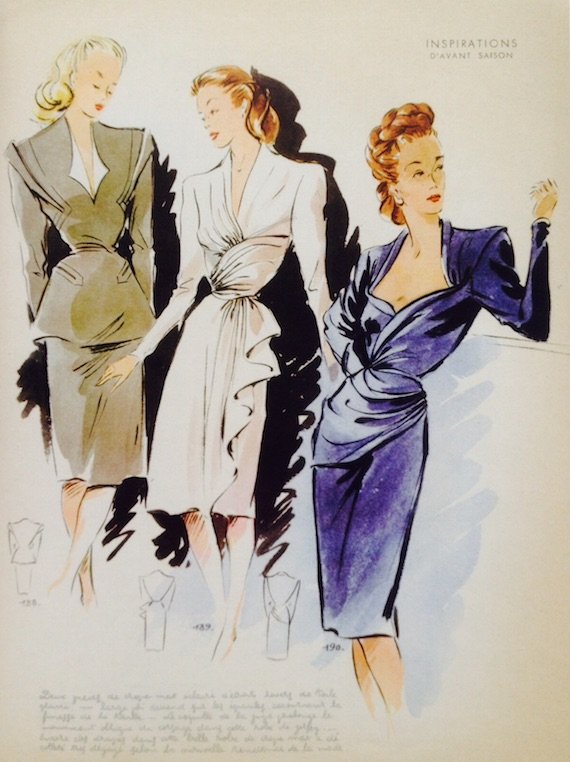
French-fashions-1947
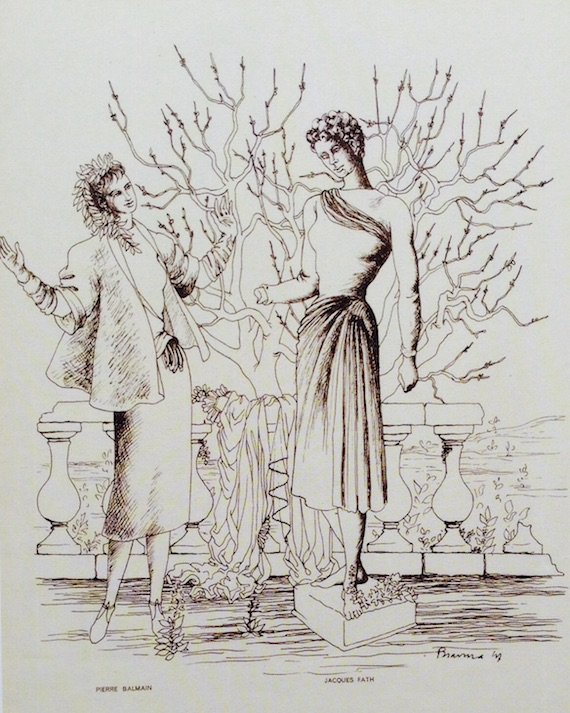
Designs-by-pierre-balmain-and-jaques-fath-1947
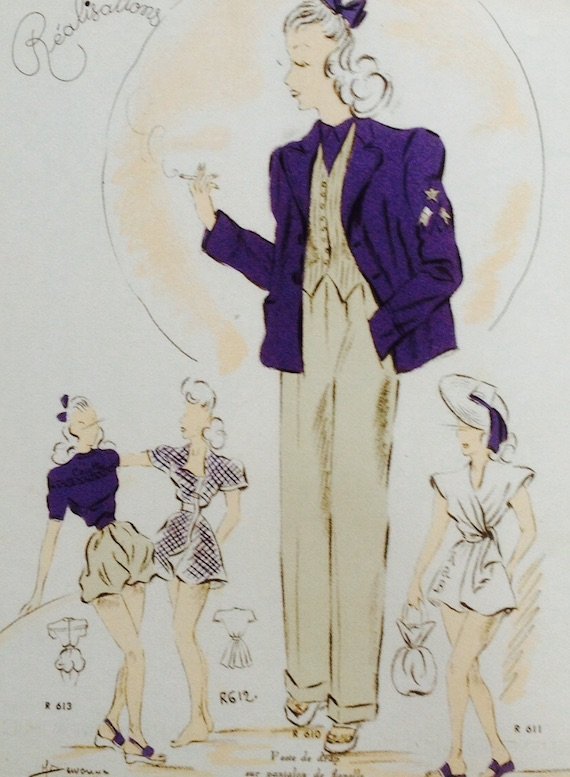
Masculine tailoring and embankment outfits for parisian couture, 1947.
A controversial fact – the bike of Parisian 1940s fashion did continue to turn in the 2nd Earth State of war. While France was nether German language occupation, the President of the Chambre Syndicale de la Haute Couture, Lucien Lelong, fought with the Nazis to keep the way industry alive, in order, he said, to keep jobs and prevent those involved from being sent into potentially dangerous war work for the Germans.
Many 1940s fashion houses did close, in what couturiers hoped would be for the duration of the state of war but they were forced to re-open up under threat of the businesses existence treated as abandoned and taken possession of past the German state. Simply customers from neutral countries, those who sided with Frg, or of course, Germans could store the Parisian 1940s fashions or fifty-fifty visit France, so naturally British couture customers had no thought what was going on.
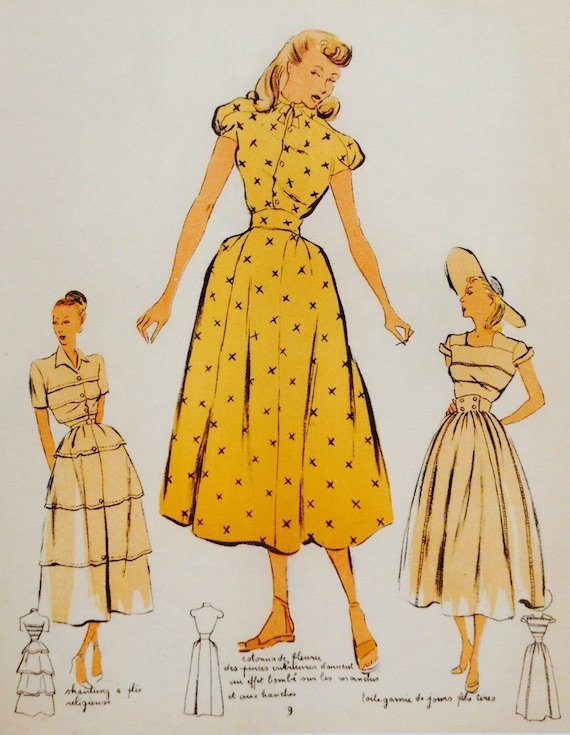
Full skirted French fashions, 1948.

The French 24-hour interval dresses in the New Look way, 1948.
Paris couture Houses in 40s fashion
Paris couture continued to produce their twice yearly 1940s way collections. The controversial part was the idea of these couturiers dressing the enemy: bending to a Nazi officer's wife with a mouthful of pins and declaring she looked glorious in her Parisian silks while French women were now in rags.
Or, mayhap worse, they were dressing those French who collaborated with the enemy – some chosen Lucien Lelong himself a collaborator. And of class, putting keen resources into such frivolousness was considered inconceivable, peculiarly in nations similar England who had narrowed down its production as far as possible to food and bombs.
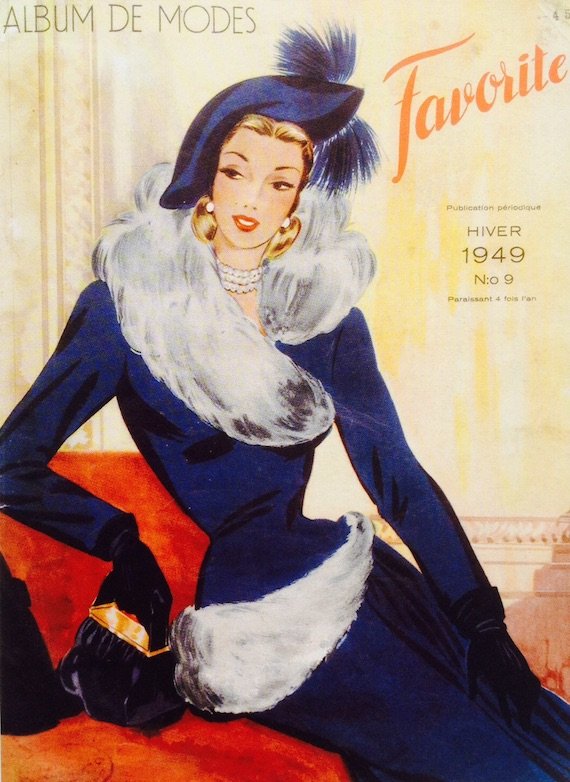
Furs for the French woman in 1949.
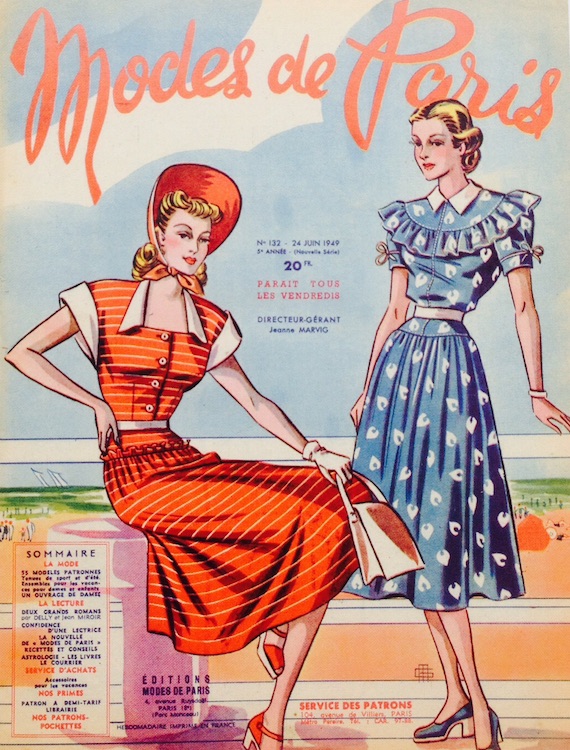
French-fashions-for-summer-1949
Disobedience
Some designers outwardly complied with the German's rules yet at the same fourth dimension stuck up two fingers to them – Madame Gres was repeatedly in trouble with the German authorities for doing things like designing 1940s fashion collections in red, white and blue, the colours of the French flag.
Others stepped out of the fray altogether, but couldn't exist considered patriotic – Coco Chanel never dressed High german officer's wives, but spent the whole war holed up in the Ritz with her lover – a German officer.
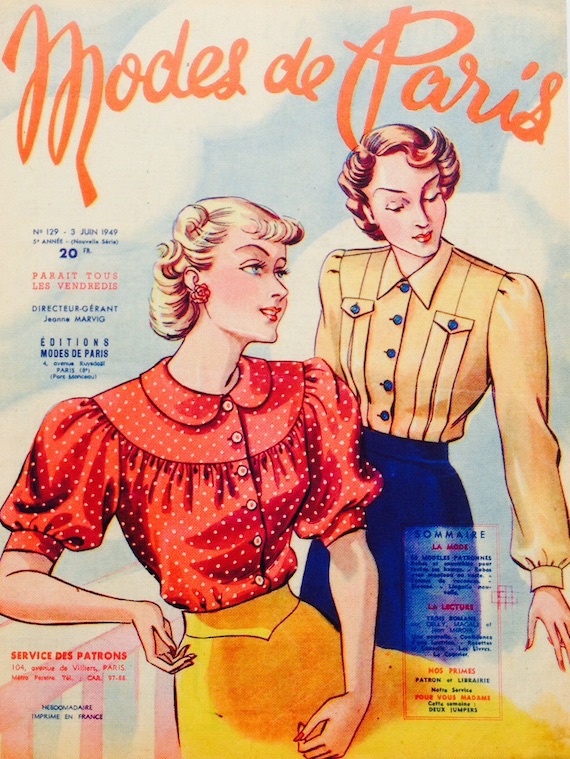
1949 Parisian fashions
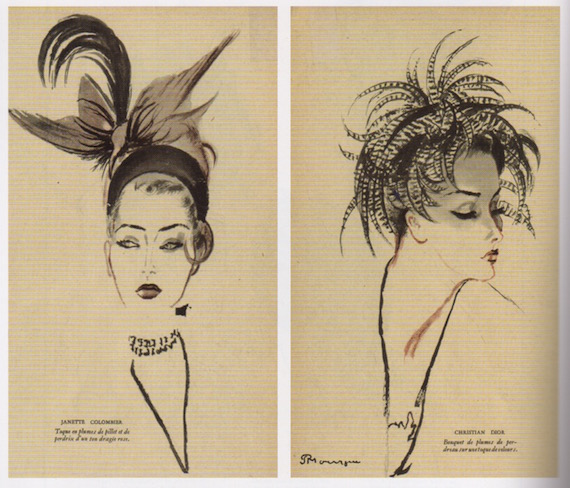
French hats of 1947.
French women had a different state of war-fourth dimension attitude altogether to war and clothes. Whilst British women were encouraged to exist patriotic by foregoing mode and making great sacrifices in clothing, French women showed their patriotism by defying their victors and wearing the about extreme fashions possible, with huge and alpine hats, impractical high heels and improvident amounts of fabric used on dresses.
When Parisian mode went back to its usual footing in 1945 afterward the liberation of France, couturiers presented these decadent pieces in their collections merely they were rejected by the way press since most of the rest of the world was still under austerity.
The 1947 "Corolla" collection of Christian Dior, dubbed "The New Await" which had a very full skirt, though retrospectively noted for its gratuitous utilise of fabric, was actually a toned downward style compared with what Paris had proposed in 1945.
German 1940s fashion
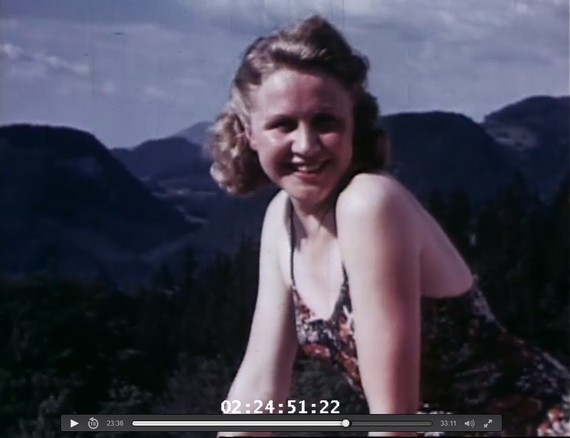
Else von Moellendorf Berghof, by Eva Braun, 1938
German women, meanwhile, were encouraged to be patriotic by renouncing style in the 1940s (considered to exist a Jewish business organization) altogether and dressing in traditional German dirndl skirts and folk embroidery, with long, un-dyed hair and no makeup. They should non endeavour to be slim as dieting damaged their chances of motherhood, which was supposed to be every German woman's goal, alongside beingness the perfect wife.
In fact, glamorous peroxide blond curls continued to be the favourite hairstyle of the German language women, alongside red lipstick, a look which even Eva Braun, Hitler's long time girlfriend, sported.
It is also slightly at odds with Hitler's wish to move the Paris fashion manufacture to Berlin and Vienna to become the new worldwide centres of style, a motion Lucien Lelong resisted, pointing out that information technology was generations of Parisian skills and preparation that made Paris the centre of Haute Couture, and that couldn't be moved lock stock and barrel.
1940s fashion in Britain
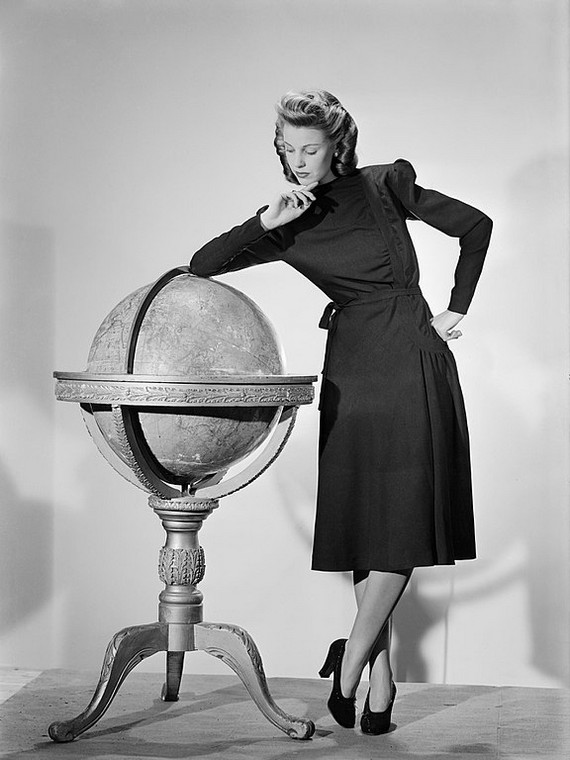
Model wearing a black woollen Utility Atrima dress in 1946
By the end of the 1930s, fashion for British women consisted of a wardrobe built around knee-length dresses, skirts and blouses, which were colourful and decorated with not merely with fabric prints but lots of flounces and surface decoration.
The outfits were topped by jackets, boleros and cardigans and jumpers for coincidental wear. They were underpinned past foundation wearable like girdles to give a flat tum and bras to give an uplifted, quite pointed bust and finished with gloves, stockings, hats and kitten heeled court shoes. The silhouette was triangular, with an emphasis on the shoulders, a nipped in waist and a noticeable pointy-ish bosom.
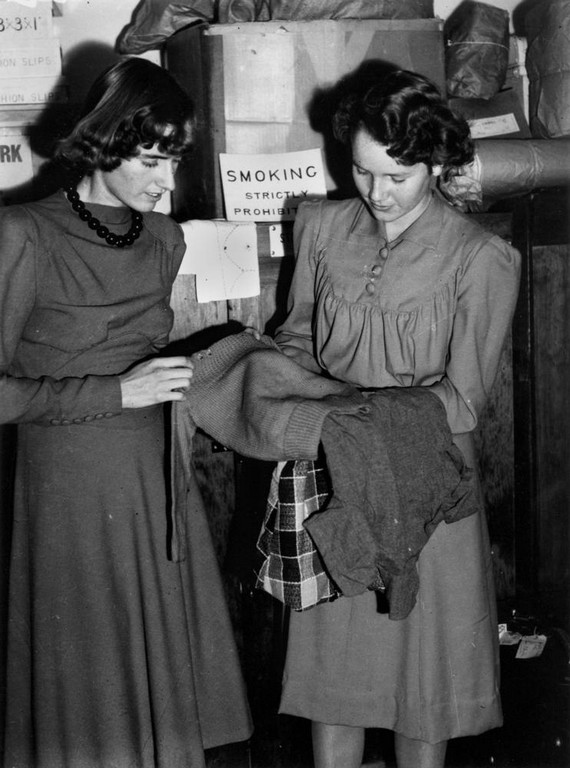
2 Utility dresses of 1942. In that location is more than textile in the skirt than before
Extras were stripped away
Coming into 1940s fashion, past the stop of the state of war dresses and skirts stayed but extras were stripped away, and gradually gloves and hats became unavailable or as well expensive, girdles were not very effective because of how they were made, and finally even stockings were no longer considered an essential, every day detail.
Dress were even so colourful simply prints became smaller as they were easier to match, and at that place was far less extra decoration like ruffles, appliqués or embroidery.
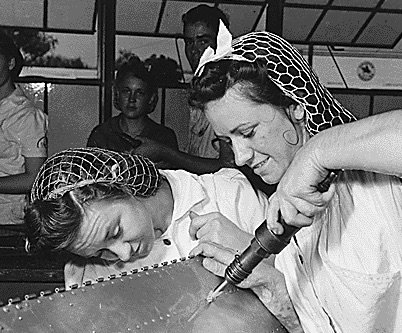
factory workers wearing crocheted hairnets.
When the war first broke out in 1939 most English language fashion houses closed downwardly. They entirely abased their carefully worked on autumn shows considering most of their London clients had left for the country anyway.
After the state of war concluded in 1945 U.k. was still under austerity and fashion connected with styles very like to war-fourth dimension ones, and it was not until very near 1948 that enough fabric and money was available for anything approaching Dior's New Look.
1940s fashion – Fashion magazines
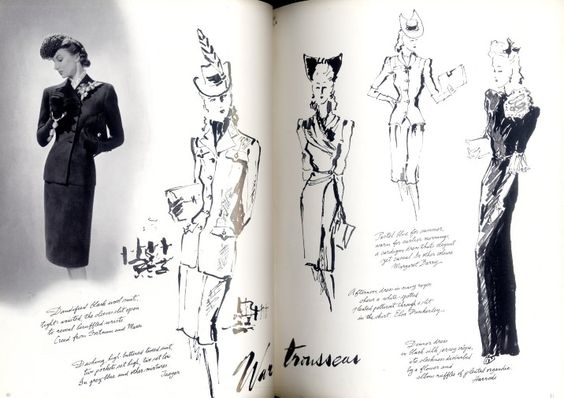
Pages from Faddy, June 1941.
Fashion magazines keep to exist published throughout the war, even when mag offices were bombed. Magazines such every bit Vogue saw their job every bit keeping British women's morale up, and giving practical advice, every bit well as presenting fantasy creations which helped them to dream well-nigh what life would be like when the war was over and things returns returned to normal.
The government saw magazines as a crucial method of disseminating information to women. They worked with Vogue and other titles on subjects similar making applied short hair seem glamorous and on keeping women cheerful during shortages, also as presenting brand exercise and mend as a chichi option.
Manner and rationing in the 1940s
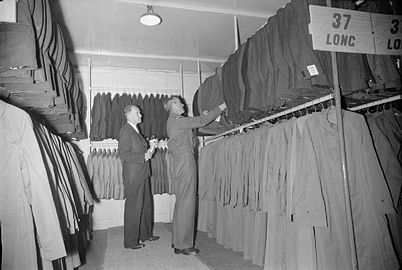
A choice of demob suits.
Clothes rationing began in June 1941, two years after food had first begun to be rationed, and it came as quite a surprise to the British who had non been forewarned of it.
Something that people today get slightly confused most is rationing and money. Ration booklets did NOT supervene upon money. They were in addition to it. Each British person got a certain corporeality of ration coupons each, and each item of wear cost a certain number of coupons each, PLUS its cost in pounds, shillings and pence. So a winter coat was, for example, 4 coupons plus £1.00, and infant'south vests were half a coupon plus a few pence.
clothing coupons in 40s fashion
Although each person got a book of clothing coupons each year, consisting of light-green coupons they could utilize at present and red coupons they had to hold on to for a few months fourth dimension, the value of coupons changed co-ordinate to what in that location was a shortage of at the time, so rarer items began to cost more than coupons every bit the state of war went on. The state of war office made continual updates, and the organization could be very confusing.
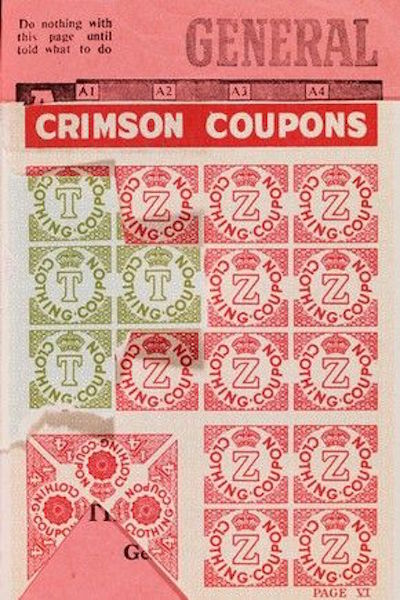
Habiliment coupons, Britain 1940s.
Just even if y'all were prepared to spend your coupons on an detail, it didn't mean that it would necessarily be in the shops, and even if information technology were in the shops, you might not be able to afford it. Aggrandizement on wearing apparel almost doubled in the state of war years, and luxury items like furs were highly taxed. Shopping for clothes meant juggling coupons, money and availability.
Black market in coupons
In that location was a black market in coupons, with early coupons being easily forged (the design was apace improved), and many coupon books being reported "lost" that were replaced, no questions asked – later claims needed a fee to exist paid along with an official postage for replacement. Poorer people who could not utilise all their coupons every bit they couldn't afford to purchase clothes often sold them for money or food, as did older people who seldom left the house and didn't need to renew their wardrobes.
Dress and food ration coupons
Clothes ration coupons were separate from food ration coupons, although at one point when the coupons themselves ran out it was announced that people could employ their margarine ration coupons instead, which reportedly led to even more confusion every bit women turned upwardly at 1940s fashion shops wielding packets of bodily margarine to swap for hats.
Shortages
The reasons for the shortages were partly imports that stopped during the war – all of Britain'south safety came from Nippon, then when they ceased sending information technology there were no more than Wellington boots or cloth for shoe soles. Habiliment factories and their workers had been turned over into making uniforms instead of civilian apparel.
In that location was also material that was made in United kingdom of great britain and northern ireland yet was now needed for war supplies – wool for uniforms and not wintertime coats, silk for parachutes and not stockings. Perchance well-nigh surprisingly, this concluding was not entirely true though.
We did need a lot of wool for uniforms but since the Board of Trade had bought the unabridged wool output of New Zealand, Commonwealth of australia and most of South Africa we had quite a lot of wool, and plenty of silk besides. The actress wool and silk were earmarked for consign, to keep the economic system afloat.
1940s utility habiliment and 40s way
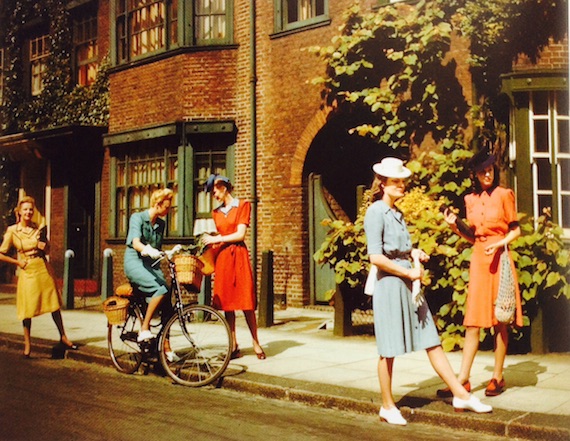
British 1942 Berketex Utility fashions designed by Norman Hartnell. Photograph James Jarche
"Utility clothing" doesn't sound so bonny, and the British population of world war ii didn't think so either. Producing or wearing utility clothing was non compulsory, but manufacturers who made it were offered greater supplies and sure exemption of their workforce from state of war work if they agreed to it, and the finished production was cheaper in the shops.
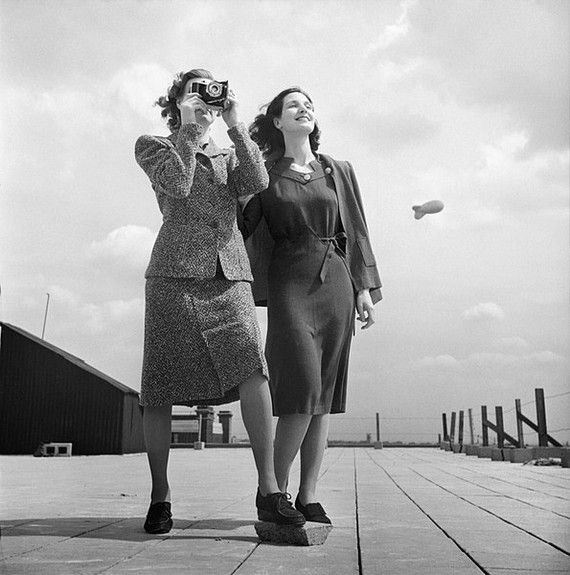
Utility fashions designed by Norman Hartnell, 1943
Colorful utility clothing in 1940s fashion
In fact, utility wearable was not some drab, grey uniform simply dresses simply every bit colourful as the usual 1940s mode, and sometimes ameliorate quality. The full general idea was to salvage fabric, and this was done by removing actress details like pocket flaps and ruffles, and making skirts a little shorter and tighter.
The printed patterns that women enjoyed were nonetheless there, just the scale became smaller to facilitate matching. Utility article of clothing was introduced across all items of 1940s article of clothing, including dresses, coats and undergarments, children and baby's clothes and menswear.
The government was concerned that the stop result was good quality, and in some cases where people had been used to dressing in second-hand wear or in manus-me-downs a fiddling daughter's utility dress was the nicest thing she had ever owned.

1942. On the left is an original W Stop accommodate. On the right is a mass-produced Utility suit
CC41 utility characterization branding
Merely even so, the public was not convinced, and then the board of trade did two things – 1 was to introduce a snappy logo, the CC41, which apace became known as known as the two cheeses for obvious reasons (in fact there were two logos, the second for "posh" utility wear, simply the two cheeses were the virtually commonly seen).
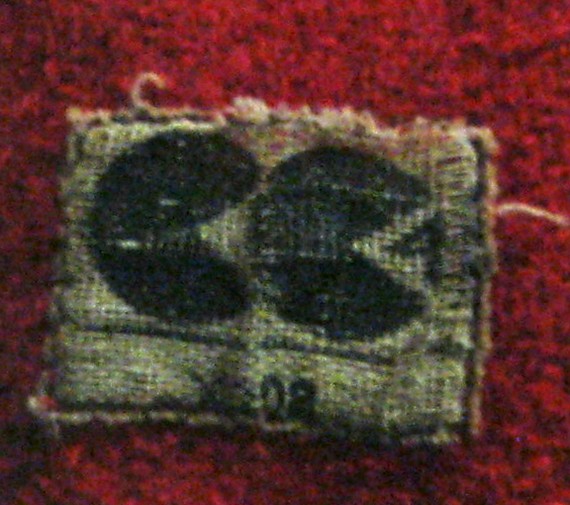
Board of Trade logo CC41. Designed by Reginald Shipp – Photo, Mona Roberts
The other was to invite a select group of high mode designers to set their minds to producing collections of utility clothing. The designers, who together formed a group called InSoc (Incorporated Social club of London Style Designers) were given special permission to leave their ground forces posts, if they were in service, to oversee the completion of their InSoc collections.
Norman Hartnell, Hardy Amies, Digby Morton, Edward Molyneux, and Bianca Mosca's designs were a bully success, and many manufacturers ordered their patterns to produce in their ain factories.
1940s national uniform?
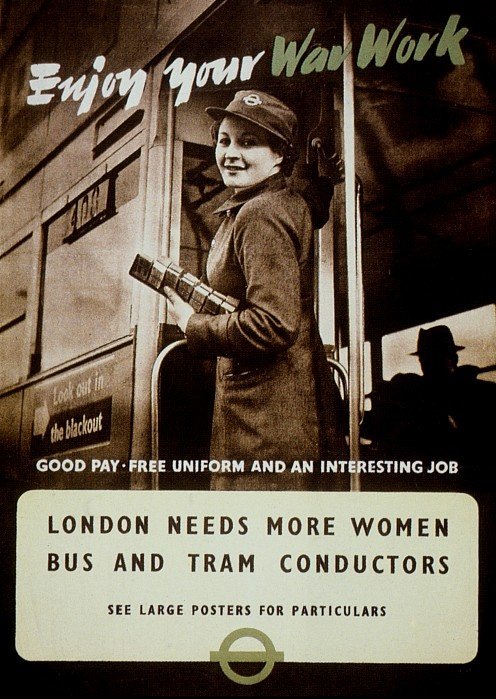
Advert for female tram conductors.
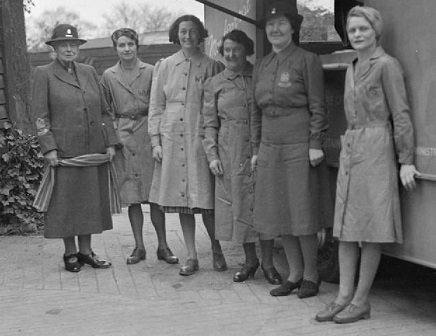
women in WVS uniforms.
The idea of a national uniform for civilians had been proposed early in the war to instil a sense of unity and national pride. It was decided that this would not sit well with the rebellious British, and looking at the efforts women made to individualise their factory uniforms, this decision was probably wise.
1940s dress – brand practice and mend

Make Do and Mend.
In 1940s Britain, the vast majority of women could knit and sew, and knew how to make their own apparel. So when article of clothing became scarce on shop rails, they naturally turned to making their ain from the material that was however for sale, or in some cases that they had stock piled.
Many women were too very good at re-making existing wearing apparel, adding a new neckband or changing the line of a coat to update it, or if they didn't already know how they revelled in the challenge. The Women's Institute began running "Thrift Classes" in 1940, and local authorities too ran clubs on dress making and renovations.
Additional working hours
Past the time the authorities's official "Make Practise and Mend" campaign came along in 1943, many women grumbled that they had been doing just that for several years already.
The campaign was fronted past an ever-cheery doll chosen Mrs Sew-and-Sew together, who gave tips on making clothes final longer past conscientious cleaning and airing, and how to dry shoes so they didn't cleft. They were certainly good ideas, but with many women now working or volunteering on top of their normal work in the house, added to their burdens.
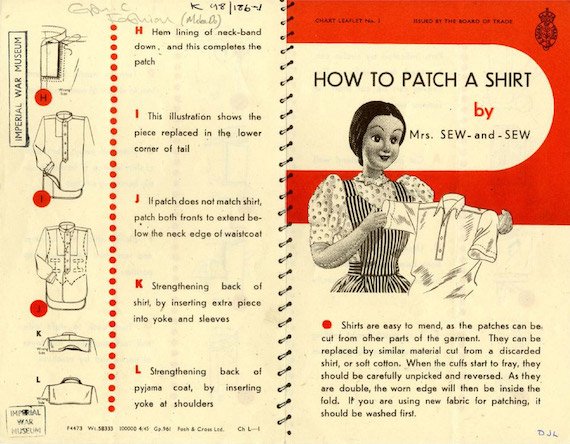
Mrs Sew together and Sew
However, it now became more acceptable, patriotic even, to announced in public in darned or fabricated-over clothes, so much so that it was almost embarrassing to admit that you had a new brim, and meliorate to boast about how information technology was some quondam thing you lot'd just freshened up if anyone admired it.
Relaxation of formalities in 40s fashion
Although some richer women missed getting dressed upward, and felt deplorable that with their husbands abroad and many social events like thousand balls cancelled, to exist replaced with slightly less elegant social affairs like sewing groups, there was no demand to dress up whatsoever more and no-one to dress upwards for, some welcomed the relaxation of social codes that meant the regular changes of vesture in the 1940s for day, dinner, evening, etc were no longer necessary, and fifty-fifty for lower class women the loftier standards of propriety were relaxed and so women now went hatless where they wouldn't have dreamed of earlier.
In some cases all social classes worked together in sewing groups or in war-fourth dimension jobs and this promoted a new understanding between the classes and sense of esprit betwixt women that peradventure wasn't hither earlier. Some women also really enjoyed the run a risk to be creative with their apparel and to be valued for being clever with their easily.
1940s 2d-hand wearing apparel
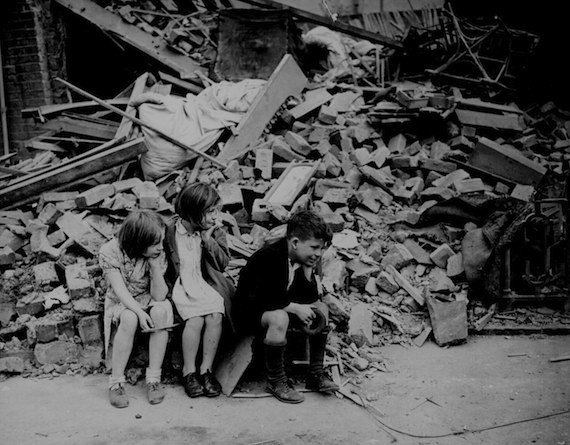
Children soon grow out of their dress.
People tried to make their ain clothes last as long every bit possible, just especially with children'south dress the second-hand market was bustling. 2d hand clothing was non rationed, but prices for that, too, inflated so wildly that eventually, in August 1941, the authorities fixed the price of second-paw items.
Second hand clothing exchanges were organised all around the land and clothing banks were prepare by charities to donate supplies of second-manus clothing to the most needy for free.
Trousers in 1940s manner
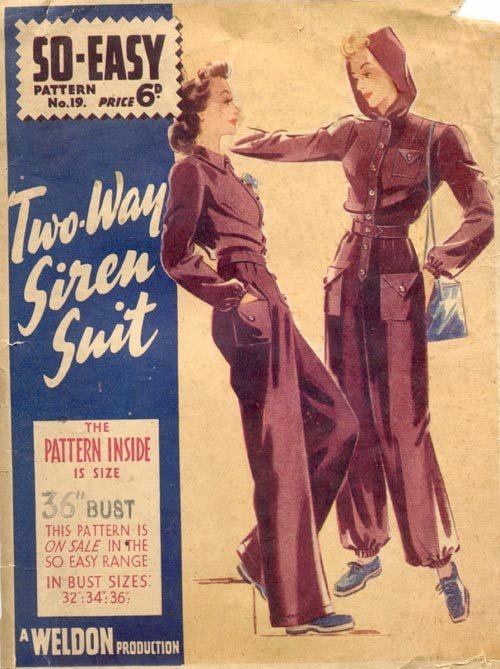
A pattern for siren suits.
Trousers had been in and out of fashion for a while by the fourth dimension 1940s fashion swung effectually, but were generally thought of every bit daring, racy or peculiar, not suitable for the eye-aged housewives of Britain.
Trousers were provided as function of some uniforms and women quickly recognised how practical they were when scrambling into air raid shelters or doing state of war work – especially as stockings were so hard to come by – but there were many disdainful comments.
"Fascinated by their new competent advent or by their long slim legs, women kept their trousers on in off-duty hours. Now yous meet trousered women in West End restaurants, sixteen stone women in flannel bags, young mothers dandling their babes in most united nations-maternal corduroys; and similar incongruous sights" sniffed journalist Anne Scott-James in 1940.
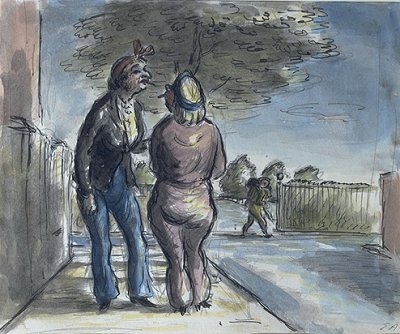
If Only They Knew What They Looked Like by Edward Ardizzone, 1941.
Yet, all in one "Siren Suits", a long-sleeved, hooded one-piece, were gladly worn in instance the siren sounded. They were mainly for females, but Prime number Minister Churchill had two.
Women's uniforms in the 1940s
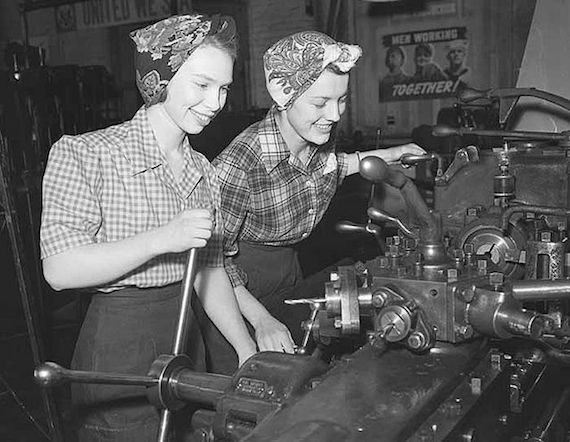
Non a national compatible. This is really Princess Elizabeth preparation to get a mechanic.Information technology shows how individual British women's wardrobes were.
Many women of the Second World War had seen their mothers climb into uniforms and work to support their country in the Offset Globe War, before existence replaced by men returning from the front end line and dissuaded from working exterior of the dwelling. Now it would exist their plow.
Conscription of Women in the 1940s
Conscription was put in place for women for the first time in British history in 1941, with single women betwixt the ages of twenty and thirty required to serve. The age range was later extended to include women between the ages of 19- 43, and Starting time Earth War veterans up to the age of fifty.
They could choose whether they joined the armed services, or worked in civil defence, the land regular army or in industry in jobs non previously open up to them. Other women freely chose to join them.
Women in WW2 worked as ship conductresses, in offices, and in factories.
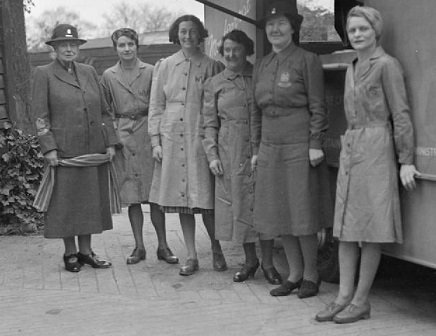
women in WVS uniforms.
Working Women in the 1940s
In a paragraph that sounds nigh unbelievable to modernistic ears, Louis Katin describes simply how strange it was to meet his wife, Zelma Katin, working as a tram usher in 1939. "It is remarkable because up till now you've just seen her at work in the home; and when yous have been on the same bus together, it's been only Every bit fellow passengers… Simply now, all at once, something big has happened. It's also the policeman slowly treading the pavement in front of who has suddenly bent down and rolled his trousers up to his knees and started to exercise a ballet dance in the eye of the street".
Zelma was given a uniform of trousers for wintertime and a brim in summertime, jacket and overcoat all tailored to her figure. Land girls were as well given their own uniform consisting of Wellington's if they were very lucky, before rubber ran out, or sturdy boots, a warm jumper, blouse and breeches or overalls.
Womens uniforms in the 1940s
Women serving were as well given uniforms. Some women were absolutely delighted with these, since they were brand new and, as one woman remembered, [it was amazing] "to have a pair of shoes that had never been worn before. They were as difficult every bit hell and I was crippled for weeks but it didn't thing. I was and then proud. Nobody else'due south foot had ever been in these shoes before me.
"Not only were the shoes hard, but many of the uniforms were not tailored to a woman's figure, with exactly the same design for male and female alike. There are stories of women steaming their wooden uniform jackets, and shaping them over their knees to create bosom room.
Some were luckier. Volunteers for the Women's Voluntary Service (WVS) were given uniforms designed by London couturier Digby Morton. Harrods fabricated and supplied information technology.
1940s underwear
If you told usa, in 2016, that we'd have to practice without tights I think we'd be mildly annoyed but not devastated. Just in an era where information technology was weird to habiliment trousers, where dresses and skirts were knee-length, where no woman went blank-legged unless they were on the beach and sometimes not fifty-fifty then, it's not hard to imagine what a blow the rationing of stockings (no tights in 1940s manner) was. Going without would feel like going out half-dressed.
Silk stockings in 40s style
Silk stocking disappeared from shops very early in the state of war, and poorly made nylon utility stockings replaced them. These were bad enough, bagging badly at knees and ankles, and stiff and badly fitting everywhere else, but eventually they became hard to find too.
The stories of women painting their legs with gravy and drawing on the seam with eye pencil are true, but probably rare, and cosmetic companies also made a "stocking cream" which did much the same job, a kind of paint on tan to which you added a drawn-on seam, but it was very expensive for daily application.
Shops promising to re-foot or invisibly mend stockings did a practiced merchandise. Somewhen in 1942 there was a proclamation from the archbishop of Canterbury which stated it was acceptable to go to church bare-legged, and hatless too. Some forward-looking government offices did the same. But most Church building going women, even if they were forced to go bare-legged to work, did their very all-time to at least get one pair together for Church on Sundays despite the edict.
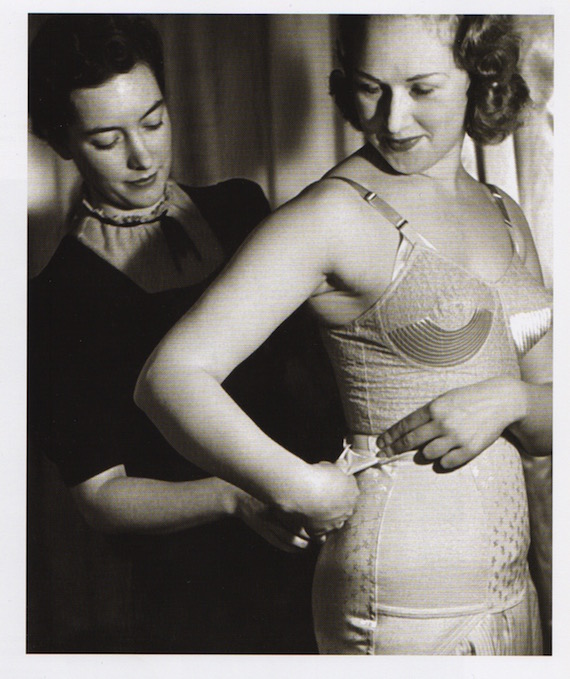
British lady trussed upwards in her underwear, 1940. The girdle has a tiny pocket.
Girdles in 1940s Womens way
Apart from stockings, women wore girdles, which were now made without steel or safe. Some complained that the new ones were literally made out of cardboard which collapsed very apace. Younger, smaller and more than daring women sometimes decided to go without and wear all in one camisoles instead, which were a revelation for some who said information technology felt as if they were wearing zippo at all.
Knickers and bras
Knickers and bras could exist made at home if y'all could go the textile, peculiarly as bras were much less complicated than they are today, coming in simply four sizes corresponding to small, medium, large and extra-large. Both of these items were commonly made without elastic which was largely unavailable, just tiny buttons instead. Some women resorted to taking the elastic out of one par of knickers before washing them, and painstakingly re-threading them into their clean pair before putting them on.
Parachute silk was used for underwear and christening and party dresses, stripped from downed German pilots or from parachute factories when fabric was damaged during construction. But information technology was quite stiff and very slippery. Architect's discarded blue prints, if you happened to know an architect, could be boiled to release the muslin within and used also.
1940s mode shoes
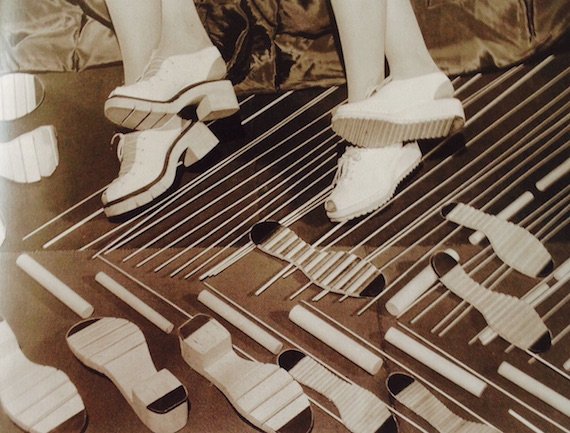
Stages of manufacturing wooden soled shoes, 1943.
Shoes in 1940s Womens style were an ugly affair. Experience had convinced women that rushing to the nearest air raid shelter in loftier heels was no fun, and delicate shoes didn't stand up up to long walks in the rain when no taxi appeared to take you habitation. Very practical, low heeled shoes were needed.
There was less leather than earlier, so smaller pieces were seamed together to avoid wastage. To make matters worse there was no condom for soles, and these began to be fabricated of forest, hinged where the foot bends. Apparently they were noisy and heavy.
Cork soled platform wedges were made for glamour girls – but compared with the delicate heels of the 1930s, even these were clumpy.

Applied brown leather Oxford shoes, 1945.
1940s fashion hats and accessories
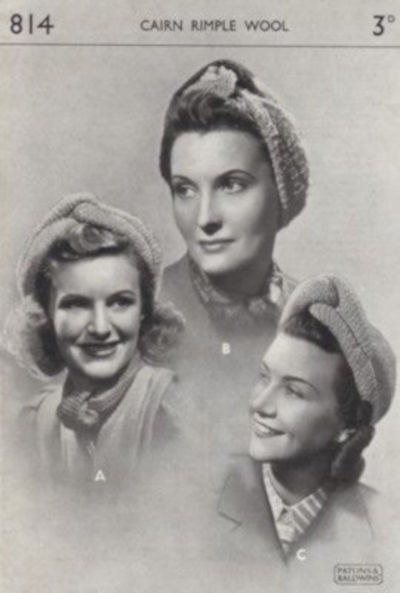
Patterns for knitting turbans.
Hats were a luxury item in 1940s fashion and therefore not subject to rationing, only they were taxed and suffered greatly from aggrandizement. They, like most luxuries, had doubled in cost and then women refurbished their old ones or more and more often, and would rather become without than article of clothing a shabby onetime one.
Turbans, sometimes pre-fabricated merely also fabricated of all sorts of cloth including dusters if they happened to go with the outfit, were popular because they covered hair that was none likewise clean with the shortage of shampoo, and kept it out-of-the-way when they were working.
Knitted and crocheted pilus nets were supposed to be applied but in a factory setting were very flimsy – in that location were stories of girls getting their pilus defenseless in machines with horrible consequences despite wearing them. In response to these accidents, condom inspectors insisted that women vesture the hated peaked caps that were part of their work outfits, with their hair tucked underneath.
Numberless in 1940s womens fashion
Large, roomy bags became more applied, and were sometimes knitted or crocheted, though of grade a lot of women simply kept using the handbags they already had. Gas masks had been handed out, and though thankfully they were never needed as gas attacks did not happen in U.k. they were supposed to be carried around everywhere – in that location were fines if you were caught without one. Information technology came with a canvas bag with a thin strap, only some more glamorous people bought specially made, more elegant numberless from companies like Turnbull & Asser.
Hairstyles in 1940s manner
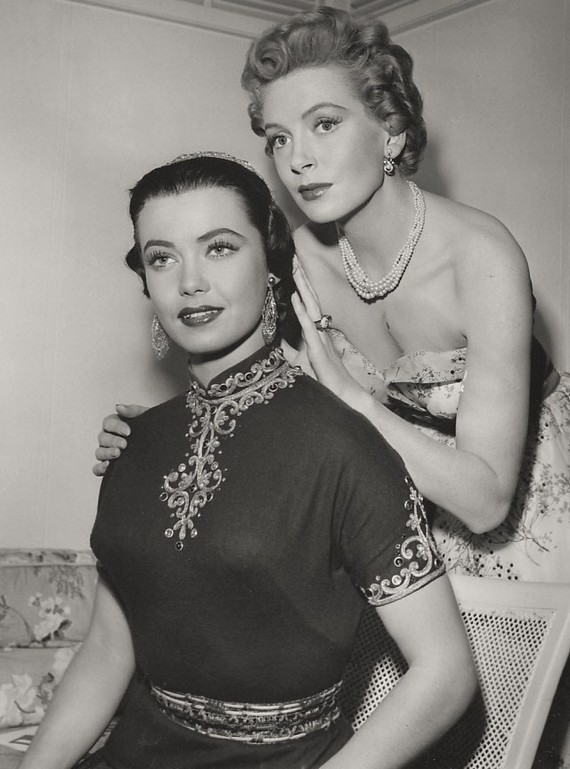
Betta St. John (left) & Deborah Kerr (Correct) , ravishing with shorter pilus in Dream Wife,1953
Service women were not allowed to wearable hair longer than collar length, and magazines suggested various practical styles, curled around the ends and held off the face, that would work well with uniform caps. They ran features on film stars like Deborah Kerr who looked ravishing with shorter hair, and their attempts at persuading the nation that short hair was amend were very constructive. With the lack of hot water and shampoo, short hair was easier to manage anyway.
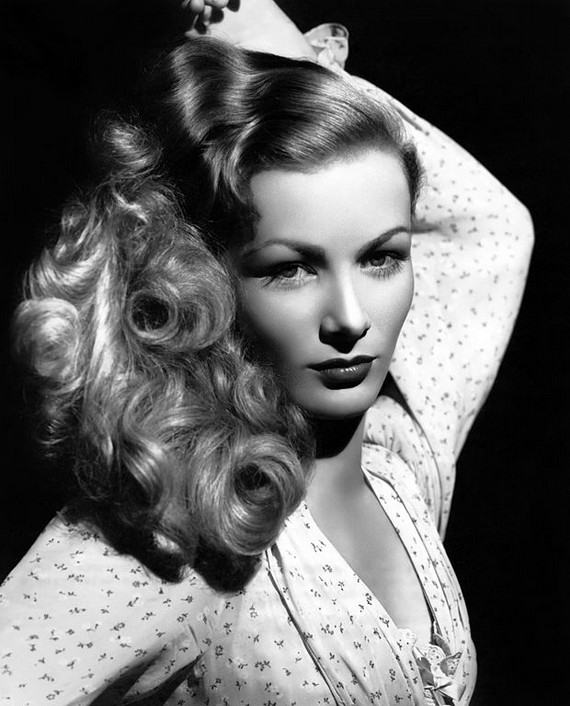
Veronica Lake, 1943
Veronica Lake, the screen star, had a much copied "peekaboo" hairstyle, with a flick of her long pilus poised seductively in front of one heart. Of course the poor girls copying information technology couldn't run across likewise well, then the Hollywood star was asked to change her hairstyle. This she did, sweeping it off her face in what became known equally the Victory Gyre.
perfumes and makeup in Womens 1940s fashion
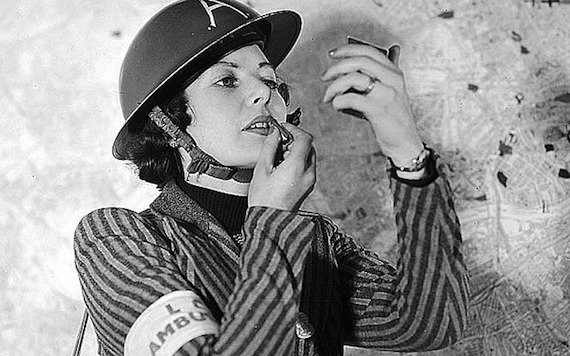
An ambulance driver attends to her makeup.
Although women were urged it was their duty to wait beautiful and stay lovely, chemical companies had been mainly given over to bomb production and cosmetics shortly dwindled. Lipstick supplies were ane of the last to go and women hoarded their lipsticks, applying lightly to make it concluding.
Tips for natural concoctions were passed around, from simple ideas like staining the lips with beetroot or berries to more complicated home-fabricated face creams. Many cosmetic companies continued to run adverts in 1940s fashion magazines, confessing that they had no supplies just nevertheless simply urging customers to stay loyal.
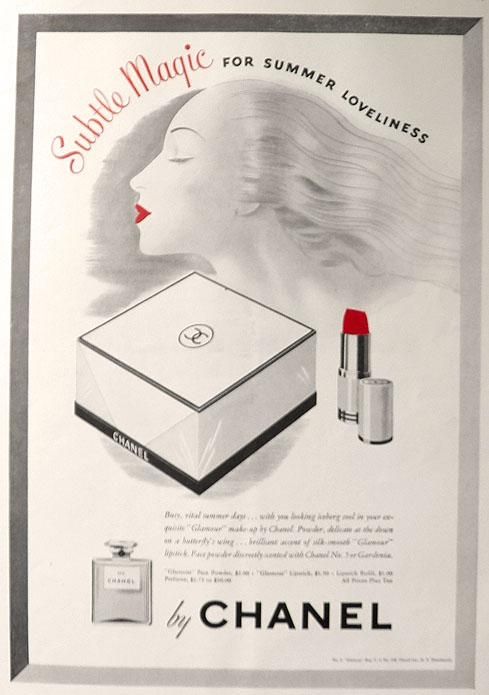
Chanel ad 1942.
Companies who did have ingredients tried to diversify, promoting creams for factory worker's complexions or protective mitt creams. Some war workers, such as those making bombs or weaving baskets, which was particularly difficult on the hands, were allowed protective confront or hand cream off ration.
1940s wedding dresses
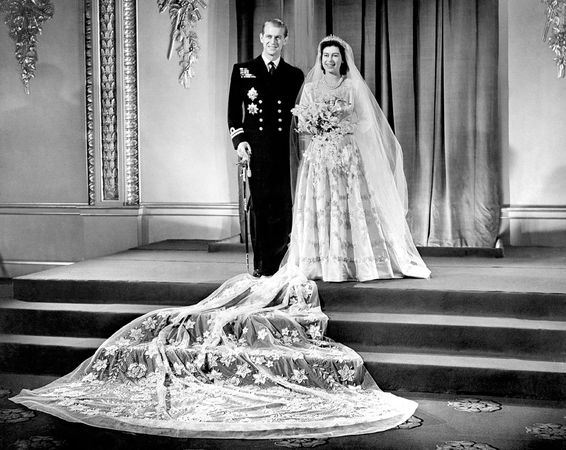
Princess Elizabeth gets married, 1947.
Wedding dresses, the sort nosotros retrieve of now, white, frothy and worn only once for the big mean solar day were a huge luxury in the kickoff half of the century, and many women even before the war preferred to buy or brand a new wearing apparel that could exist worn on other occasions, or if they couldn't afford a new ane to wear their all-time clothes with a new hat, maybe.
This was continued during the state of war. Although many rich women wore white froth (including the current Queen, and so Princess Elizabeth, who propaganda said saved her coupons and pennies just like anyone else to get her massive embroidered gown, which was made by Norman Hartnell in 1947) many decided on a simple arrange, and wore it once more and once again afterwards – not necessarily for work but for other people's weddings and other smart occasions.
Some did wear a dress, non e'er white just defiant carmine, and some fabricated a version of the traditional gown in parachute silk or even upholstery fabric (which was not rationed at the beginning of the war).
Barbara Cartland
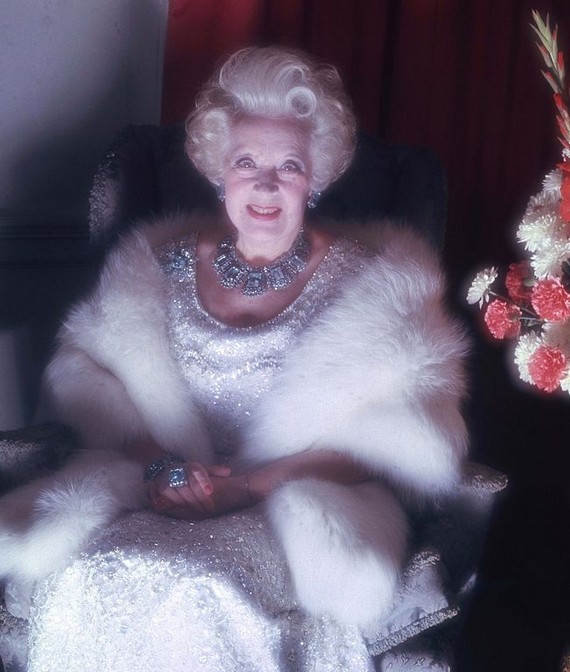
Dame Barbara Cartland, 1987, Photo past Allan Warren
Service people were supposed to wearable their uniforms. As we've seen, these were not the stuff of many women's dreams. Barbara Cartland, the romantic novelist, certainly didn't think then. She spent what would be well-nigh £500 today of her own money in buying ii second-paw hymeneals dresses. These she took to the Chief Controller of Women'southward Forces, asking the War Role to provide the money for a whole collection of wedding dresses in different sizes. They agreed, and Barbara travelled up and downwardly the country purchasing second-hand conjugal gowns, to exist borrowed by service women for their big day, cleaned and returned for the next bride.
She succeeded in giving many women the day they'd always dreamed of in a fourth dimension where there was not much to look forward to at all.
1940s mode – the finish of rationing
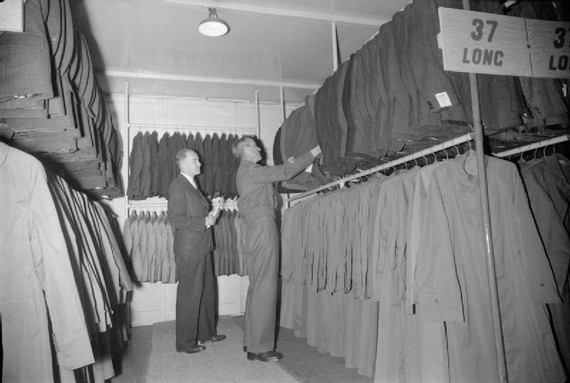
A choice of demob suits
Clothing austerity for men ended in 1944. In that location had been fierce resentment at some aspects of utility clothing for men – including the loss of their trouser turn ups, and the shortening of the knee-socks they were used to into nine inch socks, more like the length we often see today. There were other cloth saving modifications also, but these were the ones that actually seemed to make men see ruby-red. The government didn't desire their returning heroes to come dorsum to England and face the ignominy of brusk socks, so normal male person clothing was re-instated.
De mob suits and wear coupons
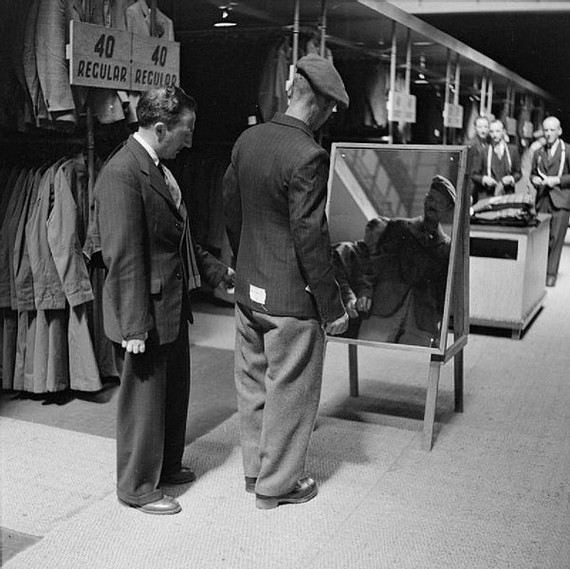
Private Nib Krepper, Pioneer Corps tries his demob suit in front end of a continuing morror with a civilian tailor at the demobilisation habiliment depot, Olympia, London, betwixt 1939 and 1945
In add-on, service men received the wonderful gift of a full suit of ready-fabricated apparel worth about £480 in today'southward money and three times as many clothing coupons every bit his civilian analogue. Service women on their return had no such welcome, although they did receive equivalent greenbacks and clothing coupons.
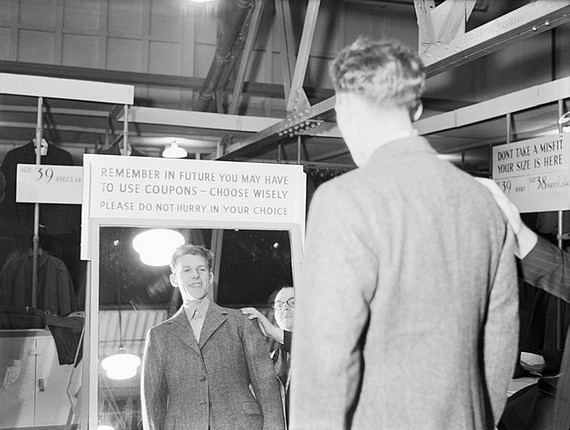
Aircrew training cadet views his new demob suit at a civilian clothing eye in Wembley, 17 October, 1944
The problem was, with clothing still scarce in the shops, many institute it quite hard to actually find the clothes they wanted. Utility clothing for women only ended in 1949, and it took several years for manufacturing and supplies to get dorsum to normal in Britain.
Even when they did, social mores around 1940s fashion clothing had changed forever, as women had learned through necessity that to become hatless, glove-less, with minimal support underwear and barelegged was OK in 1940s fashion – the mod woman was born.
A model tries on a Utility conform, date unknown. Photo by James Jarche.
Veronica Lake's Victory roll.
How Hitler wanted women to dress.
Christian Dior shows some of the underwear needed for his new creations, 1947.
Save





0 Response to "Whatb Was Fashion Like Before Ww2"
Post a Comment